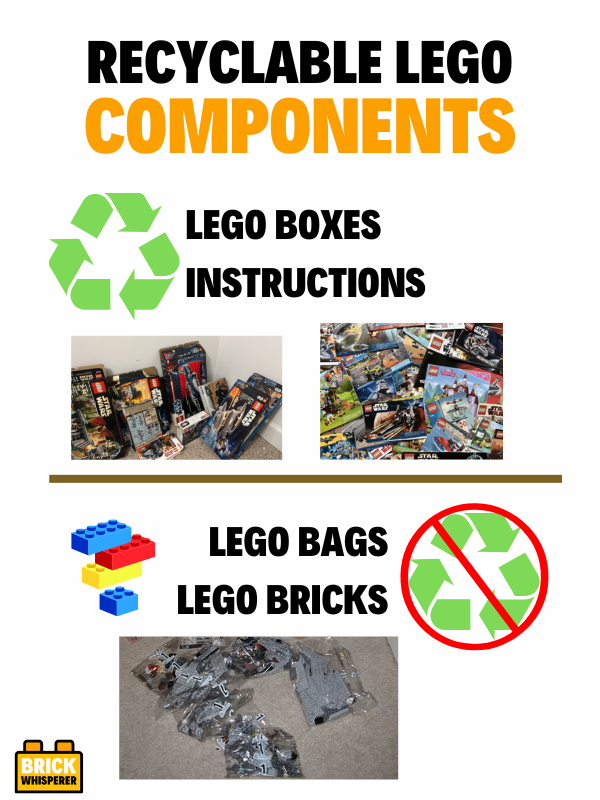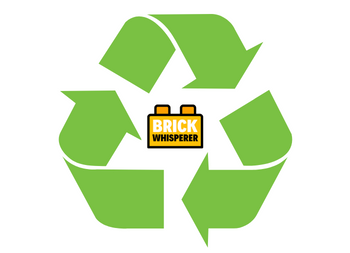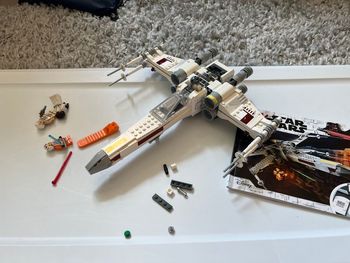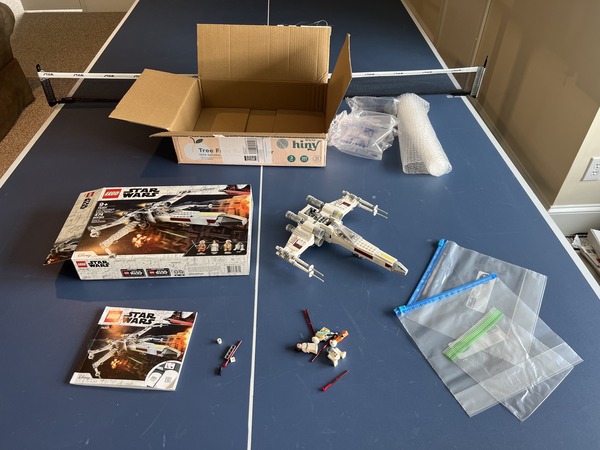Which Lego Components are Recyclable (and Which Aren’t)
In an effort to become more sustainable, Lego has announced that it’s reducing the usage of plastic bags in its packaging and moving towards paper-based packaging. Its overall goal is to have completely recyclable packing by 2025 (Source). Until then, in the spirit of being sustainable, I can’t help but wonder what components of a Lego Set can we recycle and what can’t we? So, I did some research.

Are Lego Bags Recyclable?
The plastic packages that hold Lego pieces in a Lego Set are made of #5 plastic, which is not suitable for recycling. They are considered single-use plastic bags, which is why Lego is moving to make their packaging more sustainable.
Only thicker #1 and #2 plastics meet the minimum legal requirement to be considered recyclable. You may find recycling bins that claim they can recycle Type 4, 5, and 6 plastics, but they usually end up in land fills or incinerators, which includes your Lego bag (Source).
Short of throwing them away, the best option for a chance of your Lego bag getting recycled is to take it to the bag return at your local grocery store. Those bag returns aim to either reuse or recycle single-used plastic bags, which are also made of Type 5 plastic or polypropylene.
Lego Instructions are Recyclable, but Don’t!

Lego building instructions are accepted at most recycling centers and curbside bins. They are made of polymer plastic, which is easily recyclable. It’s the same material used to print magazines, and can be recycled several times to be used for new magazines and catalogs.
While instructions are recyclable, I would not recommend it! It turns out they are more valuable than some people may think. The only time I would tell someone to recycle an old booklet if it was ripped up and missing pages. Otherwise, you could be throwing away money.
People buy and sell used instructions on eBay and various Lego selling sites every day. In my article Always Keep Your Lego Instructions! (Here’s Why & How), I found various examples of people selling their piles of instructions for sometimes as much as $50! That’s much better than taking them to the recycling center!
On top of that, I did a study in the same article where I questioned whether or not Lego sets sell for more if you keep the box and instructions. I browsed the recently sold section on eBay for 7 different Lego sets and marked down whether or not it was sold with the original box, instructions, or neither. I found that by keeping a lego set’s instruction manual, but not the box, it will sell for 3.20% more on average.
In short, keep your instructions. Don’t recycle them. If you’re curious about the studies I do here on BrickWhispherer, check out my Case Studies page.
Lego Boxes are Recyclable, but Don’t!

Lego set boxes are accepted at most recycling centers and curbside bins. They are made of cardboard and can be recycled anywhere that accepts paper and cardboard. It’s good practice to flatten each Lego box you recycle.
Despite Lego boxes being recyclable, I urge you not to take them to the recycling center unless they are seriously damaged. Otherwise, they could be valuable. In the same study I mentioned earlier, I kept track of whether or not the 7 sets were sold with the box. I found a staggering difference between the two!
It turns out that by keeping a Lego set’s box and instruction manual, it will sell for 10.50% more on average. It was hard to find sets where the sellers kept the box but not the instruction manual, so I’ll assume it’s the box that’s adding most of the value. Sets sold with just the instruction manual saw a smaller 3.2% increase on average. You can read more about this study on my Case Studies page.
I’ve also seen people sell Lego boxes for a very decent price on eBay! The more expensive the set, the more expensive the box. I’ve seen smaller set boxes sell for $10, which is still great, and I’ve seen larger set’s boxes sell for as much as $60! I’d check what your box is selling for on eBay before recycling it.
Are Lego Bricks Recyclable?
Lego bricks are made of Acrylonitrile Butadiene Styrene, which is easy to recycle. The Lego Group picked this material in order to break down old Legos and make new ones, on top of being a durable and hard plastic. However, they encourage people to reuse and donate old, unwanted Legos instead.
So in theory, you can take old Lego bricks to a recycling center that accepts plastic items. However, I would encourage you take part in Lego’s Replay Program. If you haven’t heard of it, Lego will cover the shipping cost if you fill a box with any Legos you want to get rid of and ship it to children in need. All you do is fill a box, print the shipping label, and drop it off at your nearest post office.
Fore more information, here’s a link to the Lego Replay Program. They’ll explain the process in more detail and show the good the program has done.





